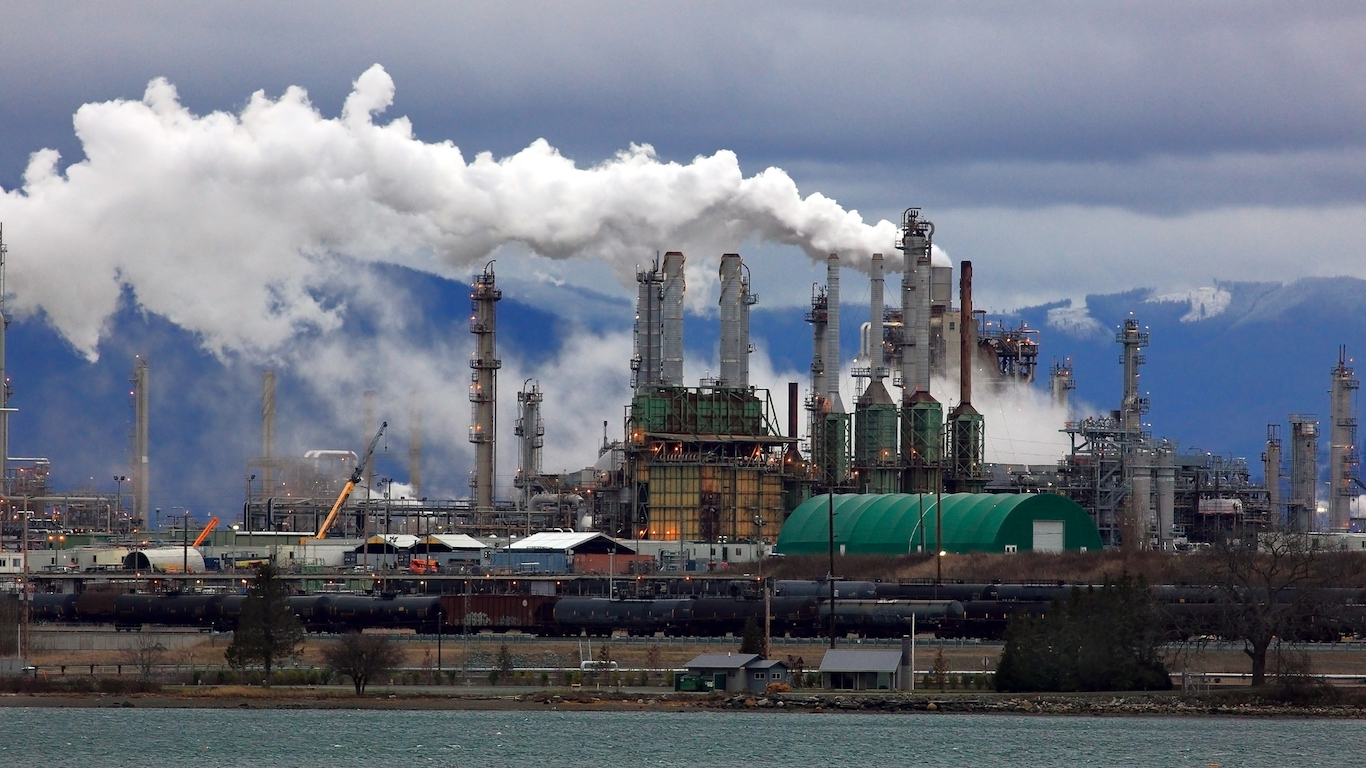
The United States is the world’s second largest greenhouse gas emitter. The country announced in 2017 its plans to back out of the Paris Climate Agreement, which aims to fight global warming and its consequences by keeping the rise in global temperature below 2 degrees Celsius since pre-industrial levels. While some state governments have set their own goals to reduce emissions in line with the international agreement, others are doing little to improve their environmental footprint.
Less eco-friendly states don’t enact very aggressive local restrictions, if any, on energy use for its businesses and residents. Using data from the U.S. Environmental Information Administration, 24/7 Tempo created an index of air pollution levels, state electricity generation and efficiency policy, and employment in green jobs to identify the least eco-friendly states in the country. For a different point of view, these are the most eco-friendly states in America.
Electricity generation was selected for the ranking because, as a secondary energy source, it is generated from the conversion of primary sources of energy such as coal, natural gas, oil, nuclear power and other natural sources. The other secondary source is hydrogen, which is not used often because it’s not safer and it takes more energy to produce.
The burning of fossil fuels is one of the primary causes not just of greenhouse gas emissions, but also of other forms of air pollution and environmental harm.
Click here to read about America’s least eco-friendly states.
To determine the least eco-friendly states, 24/7 Tempo created an index of five energy and pollution-related measures: 1) The share of electricity generated in the state coming from renewable sources. 2) State policies related to energy efficiency. 3) Air pollution levels 4) The share of jobs in green industries. 5) The share of electricity generated from oil, coal, or natural gas combustion.
Average daily density of fine particulate matter is measured in micrograms per cubic meter and is from County Health Rankings & Roadmaps, a Robert Wood Johnson Foundation and the University of Wisconsin Population Health Institute joint program, and is for 2014, the latest year for which data is available. Electricity generation by source is for 2017 and comes from the U.S. Energy Information Administration.
The share of jobs in green industries by state comes from the U.S. Bureau of Labor Statistics’ Quarterly Census of Employment and Wages and is for 2017.
Each state’s energy efficiency policy score is from the American Council for an Energy-Efficient Economy’s 2018 State Energy Efficiency Scorecard, which measures state and regional policy on transportation, utility, buildings, and other energy efficiency standards.
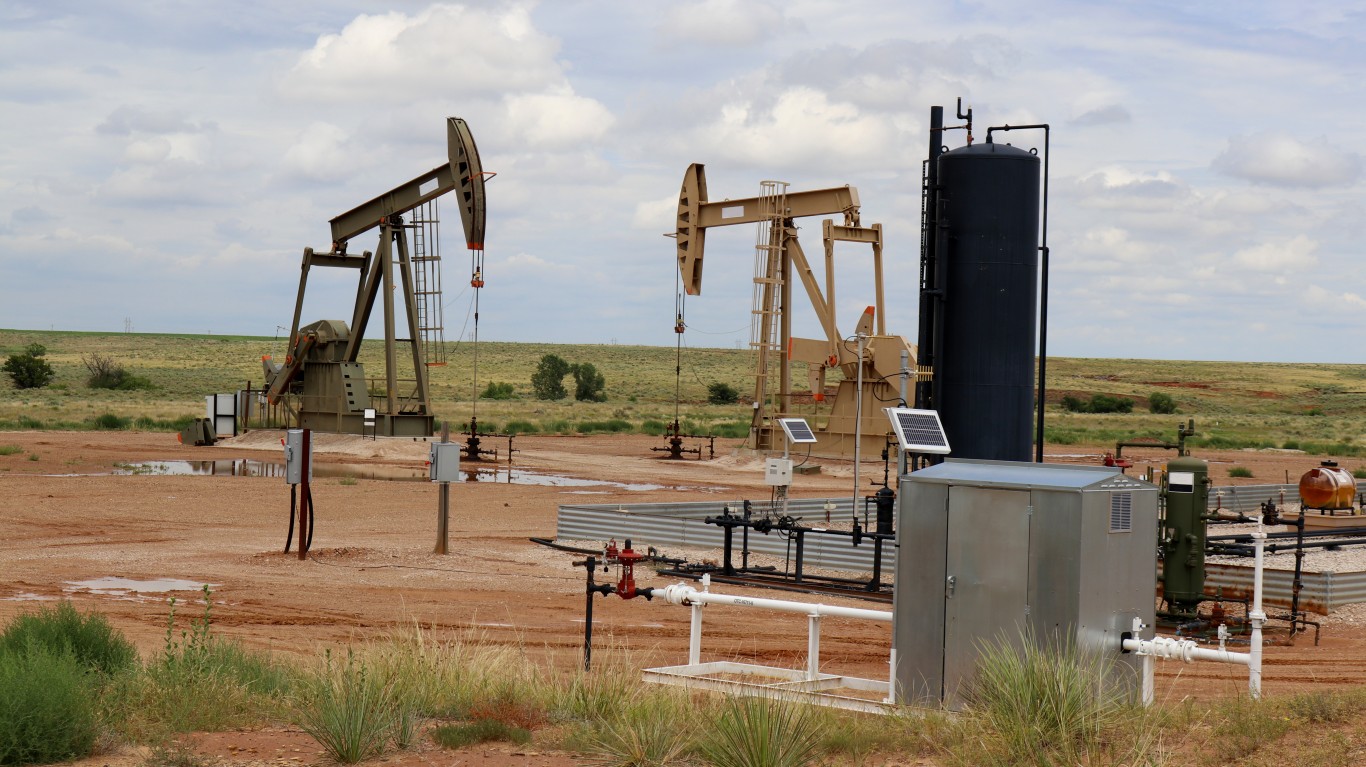
16. Oklahoma
> Electricity generated from renewable sources: 35.2% (11th highest)
> Electricity generated from fossil fuels: 64.9% (24th highest)
> Green industry employment: 15.1% (7th lowest)
> Avg. daily air particle pollution 9.65 ug/m3 (22nd highest)
Oklahoma is a major oil and natural gas producing state. The state’s industrial sector uses about two-fifths of the energy consumption in the Sooner State.
Though a relatively large share of electricity generated in the state is from renewable resources (35.2%), the state relies heavily on the oil and natural gas industry and has relatively few jobs in green industries. In terms of volume, Oklahoma is the sixth largest producer of electricity at almost 26 million megawatts.
See all stories featuring: Oklahoma
[in-text-ad]

15. Nevada
> Electricity generated from renewable sources: 25.3% (16th highest)
> Electricity generated from fossil fuels: 74.6% (18th highest)
> Green industry employment: 14.8% (4th lowest)
> Avg. daily air particle pollution 8.28 ug/m3 (15th lowest)
Due to Nevada’s location almost entirely in the Great Basin — a sun-bathed desert with no sea nearby and the lowest average precipitation in the U.S. — the state has a tremendous potential to be a solar power, according to the U.S. Environmental Information Administration (EIA). But natural gas, not renewable sources, is the primary power source in the Silver State. Of Nevada’s 10 large power plants, eight produce energy from natural gas. Fossil fuels are the source of nearly three-quarters of the state’s net electricity generation.
There is a push by some Nevada lawmakers to make the state more eco-friendly. A law that was recently filed for debate could mandate that half of the state’s energy come from renewable sources by 2030, up from the current goal of 25% by 2025, which was exceeded in 2018. Unlike most of America’s least eco-friendly states, the 25.3% of Nevada’s electricity generation comes from renewable sources is higher than most states.
See all stories featuring: Nevada

14. Wisconsin
> Electricity generated from renewable sources: 8.9% (20th lowest)
> Electricity generated from fossil fuels: 76.3 (16th highest)
> Green industry employment: 18.0% (16th highest)
> Avg. daily air particle pollution 9.79 ug/m3 (17th highest)
Located between big lakes and rivers, Wisconsin doesn’t have fossil fuel resources of its own but imports coal and petroleum primarily from Wyoming and Montana. Approximately half of Wisconsin’s electricity is generated from coal. Power plants in the state that run on natural gas have more than doubled between 2011 and 2018. Some scientists consider natural gas, which is a fossil fuel, to be as bad or worse than coal because it leads to the release of methane, a chemical that is much more powerful in trapping heat in the atmosphere than carbon dioxide.
Wisconsin has taken steps to improve its environmental profile. It passed a law that requires all electric companies to provide some of the electricity to customers from renewable sources. The statewide goal was 10%, which was met in 2013.
See all stories featuring: Wisconsin

13. New Mexico
> Electricity generated from renewable sources: 17.9% (20th highest)
> Electricity generated from fossil fuels: 82.1% (13th highest)
> Green industry employment: 16.6% (17th lowest)
> Avg. daily air particle pollution 8.24 ug/m3 (13th lowest)
New Mexico is the eighth largest producer of energy in the U.S., largely due to production of crude oil, natural gas, and coal — all fossil fuels. Power plants fired by coal produce more than half of the state’s electricity. The oil and gas sector contributes significantly to the state’s economy, offering the highest average weekly wages in the state.
The state’s wind and geothermal energy sector has great potential, according to the EIA. New Mexico’s first and only utility-scale geothermal power plant, which is located in the southwestern section of the state, came online in December 2013.
See all stories featuring: New Mexico
[in-text-ad-2]

12. Georgia
> Electricity generated from renewable sources: 7.4% (18th lowest)
> Electricity generated from fossil fuels: 67.1% (22nd highest)
> Green industry employment: 17.5% (22nd highest)
> Avg. daily air particle pollution 10.33 ug/m3 (12th highest)
Natural gas, nuclear power, and coal generate almost all of Georgia’s electricity. In fact, natural gas fuels the generation of even more electricity today than in the past. It used to be the source for just three-fifths of the state’s net electricity until about a decade ago, but it has since become the largest source of electricity generation in the state.
While Georgia has set energy standards for public buildings, there is no state law that requires companies to meet any renewable energy target. Utilities are not even required to offer net metering, a system that would allow people to set how much power is drawn from a utility. The Peach State produces 7.4% if its electricity from renewable sources, and a significant portion of that comes from biomass sources like wood.
See all stories featuring: Georgia

11. Alabama
> Electricity generated from renewable sources: 9.2% (21st lowest)
> Electricity generated from fossil fuels: 60.4% (23rd lowest)
> Green industry employment: 17.4% (25th highest)
> Avg. daily air particle pollution 10.98 ug/m3 (6th highest)
Alabama’s energy consumption per capita is among the top 13 of states, according to the EIA. This is largely due to the industrial sector — aerospace and aviation, automotive, chemical, food production, forestry, metals manufacturing, and mining industries — which consumes more than two-fifths of the state’s energy. Over the last decade, coal-fired power plants’ contribution has fallen from more than half to less than one-fourth of Alabama’s net electricity generation, but much of it has been replaced by natural gas — another fossil fuel.
Renewable energy sources supply about an 11th of the electricity generated in the Cotton State. Several electricity providers in Alabama offer home and business owners financial incentives to save energy or install renewable energy generation.
See all stories featuring: Alabama
[in-text-ad]

10. Louisiana
> Electricity generated from renewable sources: 3.8% (7th lowest)
> Electricity generated from fossil fuels: 79.8% (14th highest)
> Green industry employment: 18.8% (11th highest)
> Avg. daily air particle pollution 9.64 ug/m3 (23rd highest)
About 4.7% of Louisiana’s electricity is produced from oil, the third highest share of all U.S. states and compared to a national average share of 0.5%. The state has 17 oil refineries, which collectively account for almost one-fifth of the U.S.’s refining capacity.
Louisiana is one of the five U.S. states producing the most natural gas, and it ranks third in natural gas consumption in the country (behind Texas and California). During production, natural gas emits up to 60% less carbon dioxide than coal, but the drilling and extraction of natural gas can cause significant damage to the environment because it releases methane, which is 86 times stronger than carbon dioxide at trapping heat into the atmosphere. Still, overall, natural gas combustion effects on global warming are much lower than those from coal or oil.
See all stories featuring: Louisiana
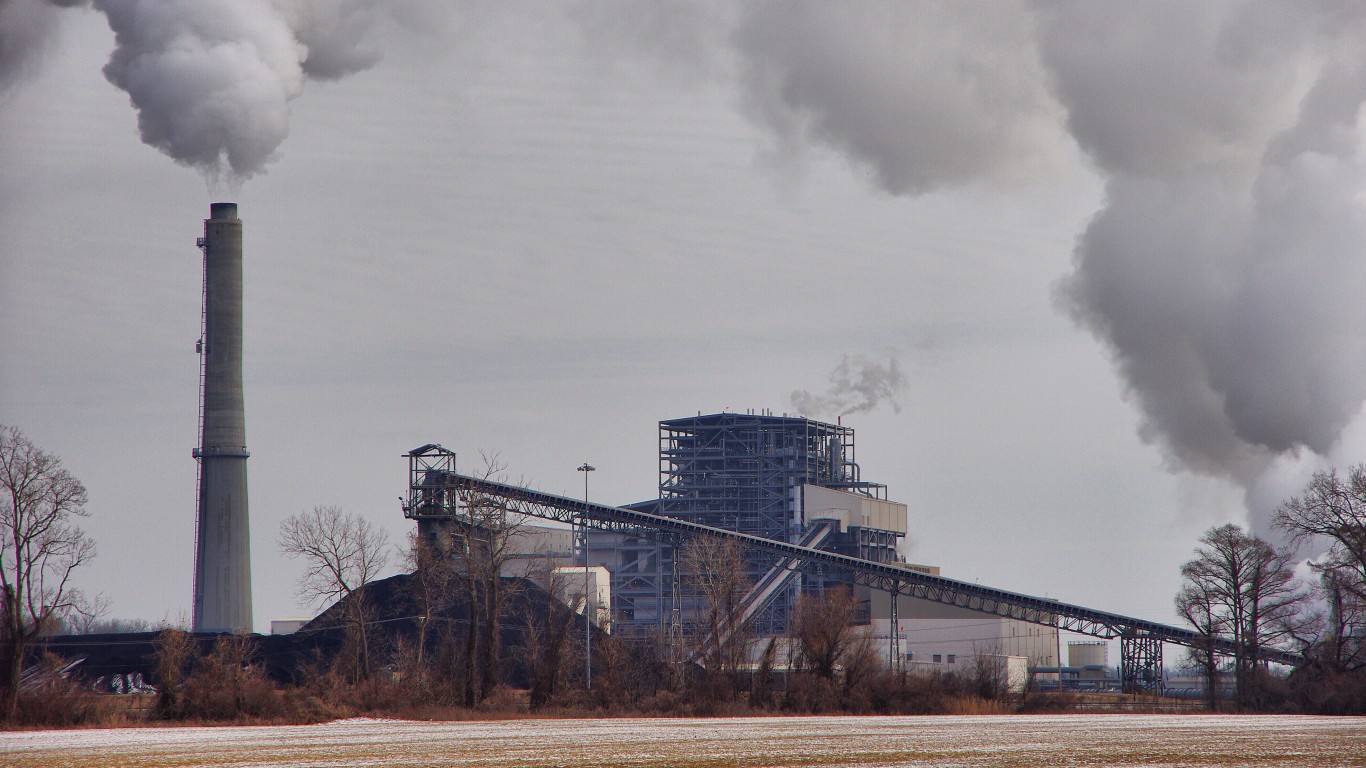
9. Arkansas
> Electricity generated from renewable sources: 7.3% (17th lowest)
> Electricity generated from fossil fuels: 71.8% (21st highest)
> Green industry employment: 16.4% (14th lowest)
> Avg. daily air particle pollution 10.43 ug/m3 (10th highest)
Arkansas produces more total energy than it consumes largely because of its high natural gas production. (It’s one of the top 10 natural gas-producing states.) The state’s per capita total energy consumption is among the highest in the country, and so is the total amount of energy used by the industrial sector. Specifically, agriculture consumes the most energy of any end-use sector in the state.
Coal is the primary source of electricity generation in Arkansas, accounting for two-fifths of the state’s net electricity generation. Over 7% of the total electricity generated in the Land of Opportunity was generated by renewable sources, most commonly from hydroelectric power.
See all stories featuring: Arkansas

8. Missouri
> Electricity generated from renewable sources: 4.0% (8th lowest)
> Electricity generated from fossil fuels: 86.0% (8th highest)
> Green industry employment: 17.9% (17th highest)
> Avg. daily air particle pollution 10.61 ug/m3 (7th highest)
Missouri’s oil and natural gas production is minor compared to other states. While the state does not have a robust fossil fuel production, it has significant fuel resources, including coal deposits and petroleum-bearing tar sands and oil shale, according to EIA. Only Texas burns more coal for electricity than Missouri.
Wind and hydropower are the two biggest sources of renewable energy in Missouri. Some of the electricity is generated from biomass, mostly wood. A decade ago, the state mandated that by 2021 at least 15% of the electricity investor-owned utilities provide would come from a renewable source.
See all stories featuring: Missouri
[in-text-ad-2]
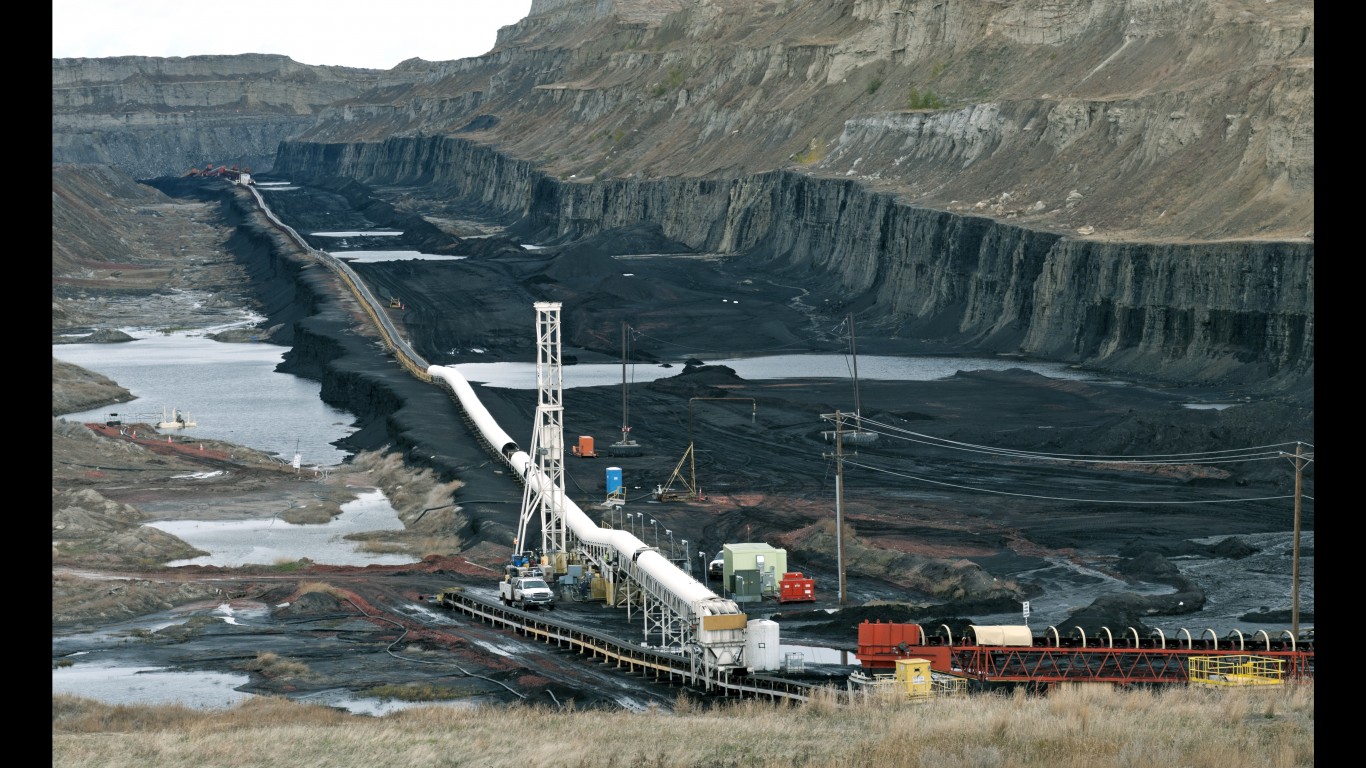
7. Wyoming
> Electricity generated from renewable sources: 11.6% (25th lowest)
> Electricity generated from fossil fuels: 88.3% (6th highest)
> Green industry employment: 16.1% (12th lowest)
> Avg. daily air particle pollution 6.73 ug/m3 (3rd lowest)
About 85.7% of electricity in Wyoming is generated from coal, the third highest share compared to all U.S. states and a national average of 29.9%. The state’s mines are home to more than a third of the country’s recoverable coal reserves. Wyoming has been a leader in coal production for over three decades. The state produces two-fifths of all coal that is mined nationwide. Wyoming is also among the top crude oil-producing states in the country as well as among the top of state consuming the most petroleum per capita.
The state has no requirements or goals to generate any amount of the state’s electricity from renewable sources. Wyoming’s very first utility-scale solar generating facility was approved last year.
See all stories featuring: Wyoming
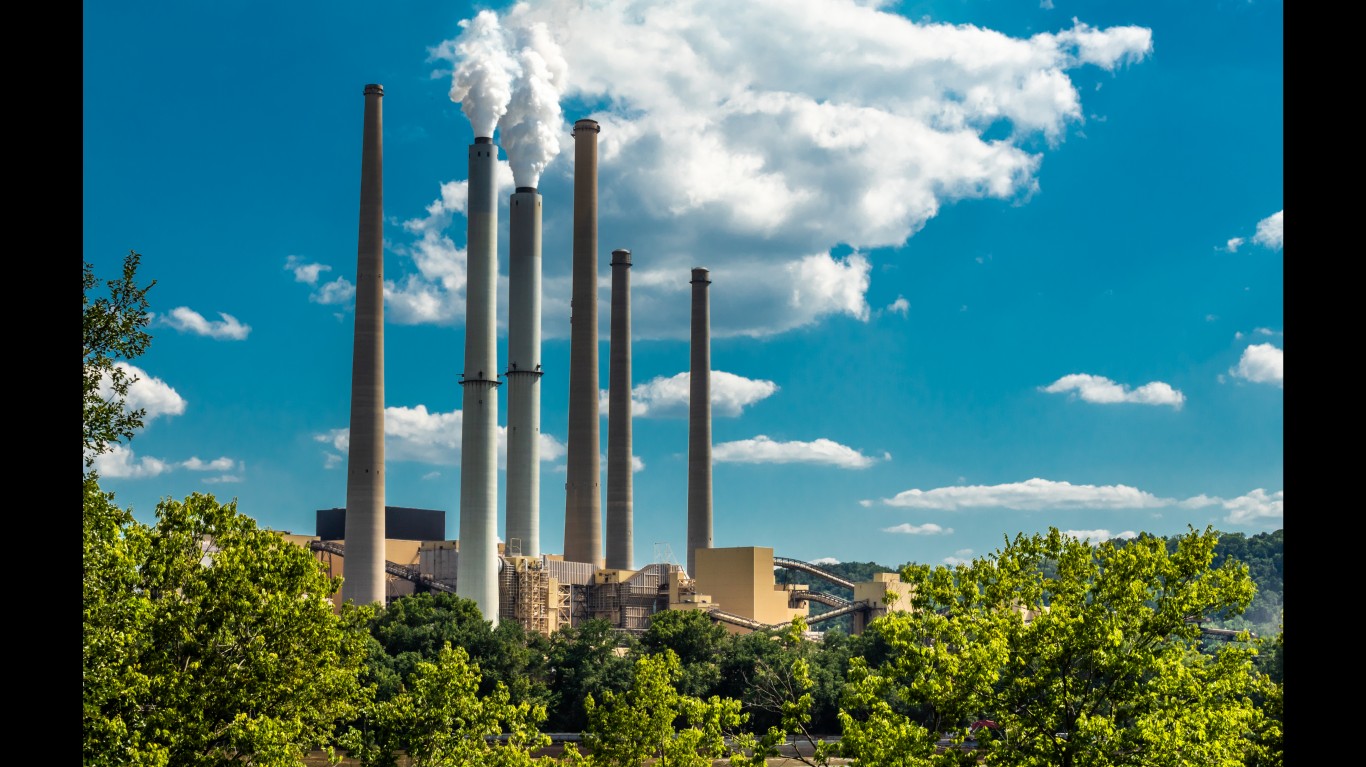
6. Ohio
> Electricity generated from renewable sources: 2.3% (2nd lowest)
> Electricity generated from fossil fuels: 83.0% (11th highest)
> Green industry employment: 16.5% (15th lowest)
> Avg. daily air particle pollution 11.87 ug/m3 (2nd highest)
The air in Ohio is not very clean — the state has the second highest concentration of harmful particulate matter per cubic meter among states. The pollution may be partially a result of the high coal production in the state. Ohio is the 15th largest coal-producing state in the country. Natural gas production has increased significantly since 2012. It increased from 0.4% of the U.S. total natural gas production to 6.5% today.
Ohio has made some efforts to improve its renewable portfolio standard. It set a goal for investor-owned utilities and retail electricity providers, but not municipal utilities and electric cooperatives, of generating 12.5% of their electricity from renewable energy resources by 2027.
See all stories featuring: Ohio
[in-text-ad]

5. Kentucky
> Electricity generated from renewable sources: 6.9% (15th lowest)
> Electricity generated from fossil fuels: 93.1% (5th highest)
> Green industry employment: 15.1% (6th lowest)
> Avg. daily air particle pollution 10.44 ug/m3 (9th highest)
Kentucky’s economy is largely dependent on energy, according to the EIA. The state is among those consuming the most energy to produce a dollar of GDP. Kentucky generates 78.2% of its electricity from coal, fourth in the nation and compared to a U.S. average share of 29.9%. The state is the fifth-largest producer of coal in the U.S., which it ships to many states in the country.
The Bluegrass State does not have a renewable energy standard or an energy efficiency resource standard. Kentucky, however, has the first net-zero energy-use public elementary school building in the U.S.
See all stories featuring: Kentucky
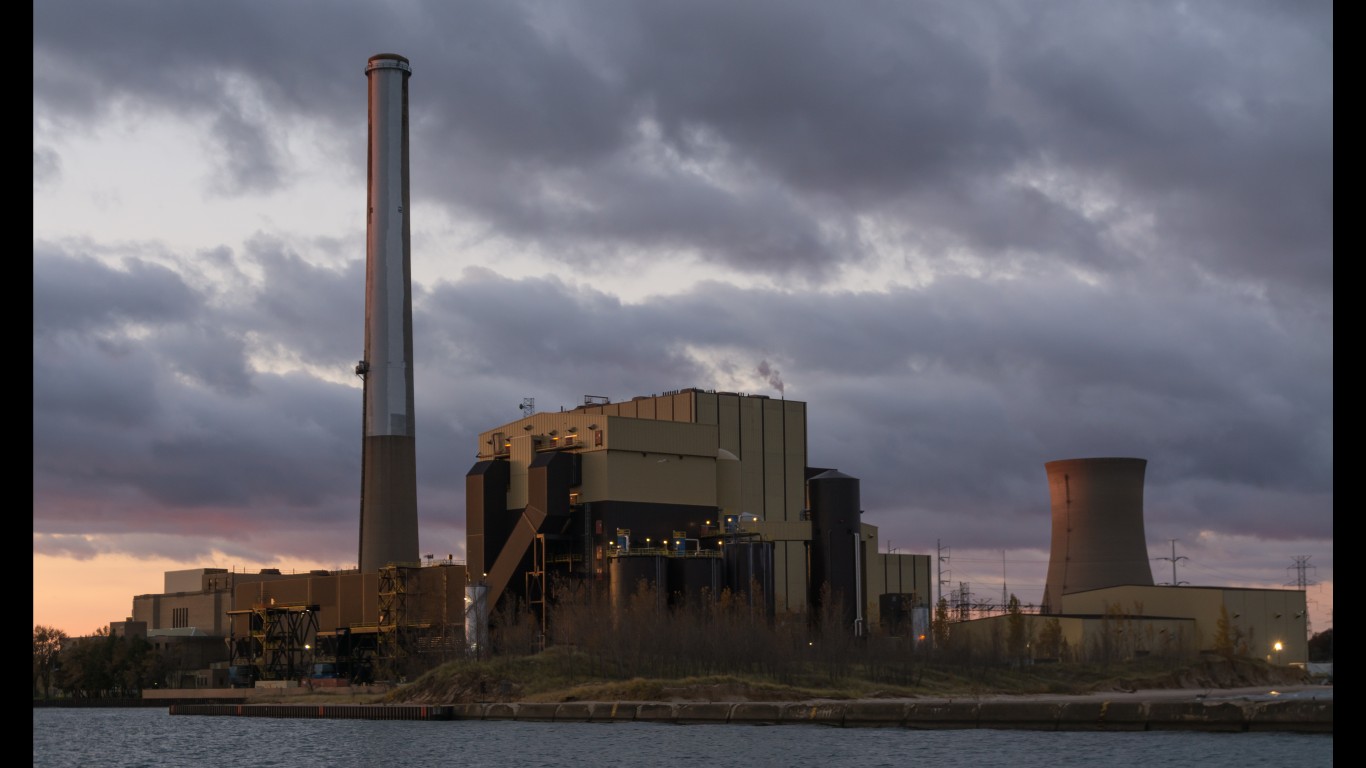
4. Indiana
> Electricity generated from renewable sources: 6.2% (14th lowest)
> Electricity generated from fossil fuels: 93.5% (4th highest)
> Green industry employment: 16.9% (19th lowest)
> Avg. daily air particle pollution 11.48 ug/m3 (4th highest)
Indiana ranks in the top 10 of U.S. states in energy consumption per capita. This is due to the state’s geographical location, which makes it prone to weather extremes from bitterly cold winters to really hot summers. The state consumes more than three times the amount of energy that is produced there.
Indiana is the eighth largest coal-producing state in the country, accounting for about 3.0% of the coal production in the U.S. The majority of the state’s largest power plants are fired by coal. Electricity generated from natural gas in the state has increased significantly — more than four times between 2010 and 2018.
See all stories featuring: Indiana
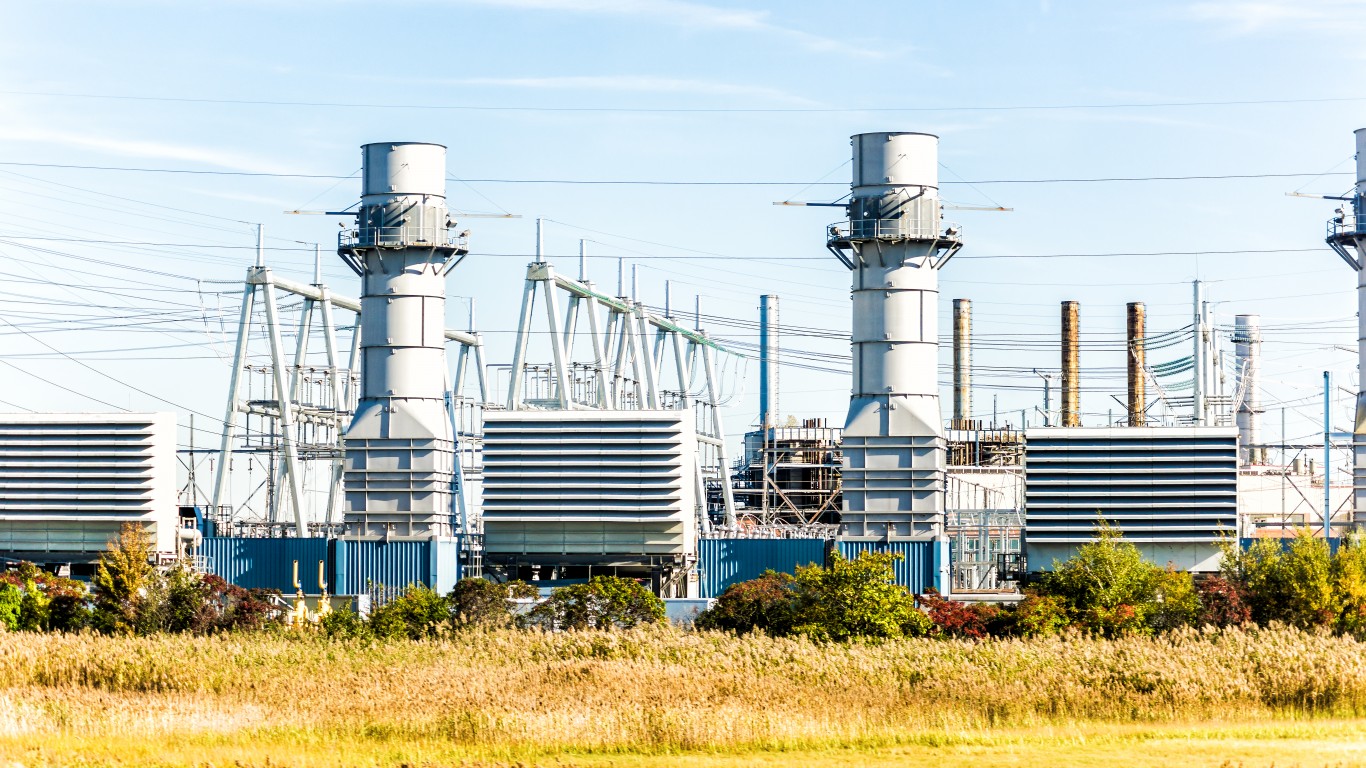
3. Delaware
> Electricity generated from renewable sources: 1.6% (the lowest)
> Electricity generated from fossil fuels: 98.4% (the highest)
> Green industry employment: 13.4% (3rd lowest)
> Avg. daily air particle pollution 9.77 ug/m3 (20th highest)
Delaware’s energy consumption is among the lowest in the United States because the state is among the least populated. Per capita, however, Delaware has higher energy consumption than more than half of states. The industrial sector, including agriculture, is the largest energy-consuming sector in the state.
The use of natural gas significantly contributes to Delaware ranking among the least eco-friendly states in the country. Just under 90% of the electricity is in the state is generated by natural gas, the second highest share among U.S. states and compared to a national average of 32.1%. Natural gas use has only increased since 2009. About half of the energy used by the electric power sector is generated by natural gas.
See all stories featuring: Delaware
[in-text-ad-2]
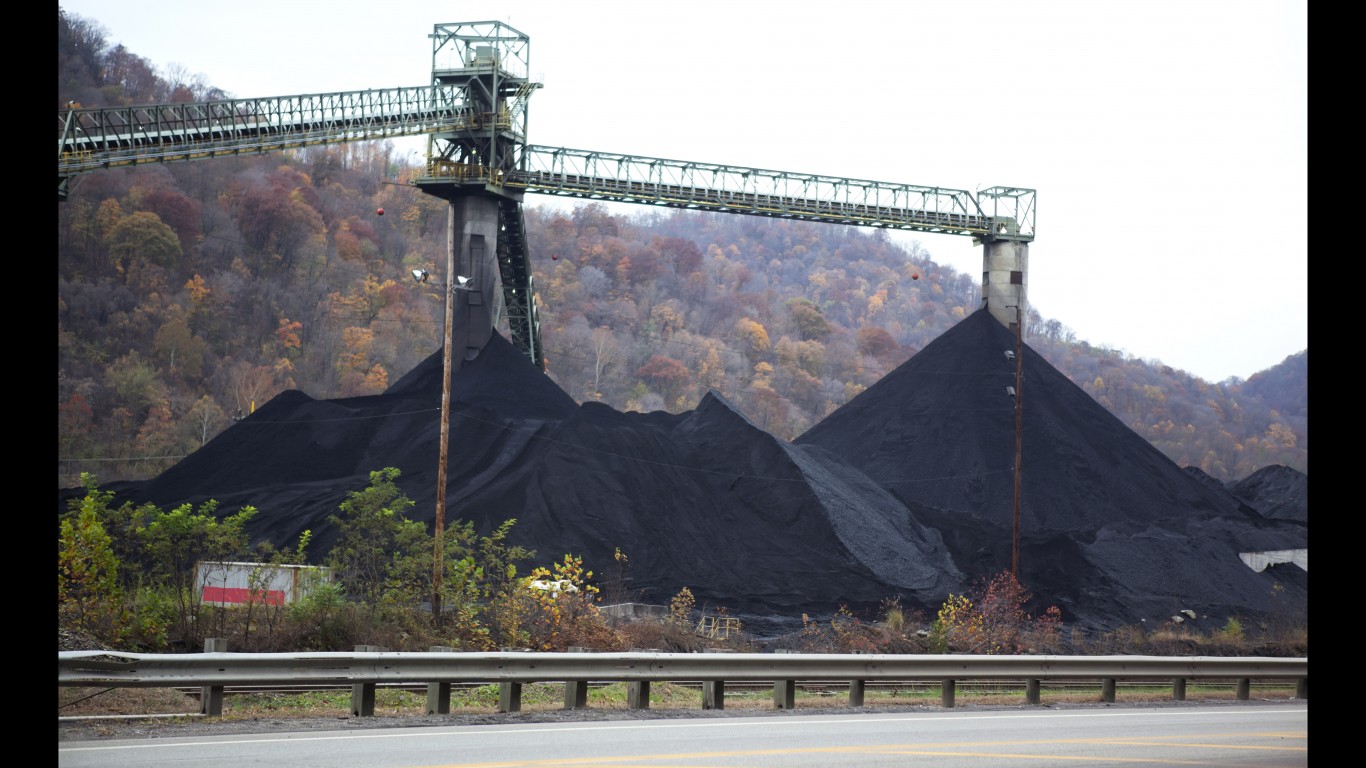
2. West Virginia
> Electricity generated from renewable sources: 4.6% (10th lowest)
> Electricity generated from fossil fuels: 95.5% (2nd highest)
> Green industry employment: 15.0% (5th lowest)
> Avg. daily air particle pollution 9.87 ug/m3 (16th highest)
About 93% of the electricity in West Virginia is generated by coal, the highest share of any U.S. state and compared to a national average of 29.9%. The state produces 11.0% of the nation’s coal as it has among the largest amounts of recoverable coal reserves at producing mines. The state is the seventh-largest producer of marketed natural gas in the U.S., mostly from shell wells. Oil production is big, too. It has quadrupled since 2012.
In terms of improving its environmental image, West Virginia is moving backwards. It repealed its renewable portfolio standard in 2015, the first state in the country to do so. It previously required investor-owned electric utilities and retail suppliers with more than 30,000 customers to provide 25% of their electricity from eligible alternative and renewable energy resources by 2025.
See all stories featuring: West Virginia

1. Mississippi
> Electricity generated from renewable sources: 2.6% (5th lowest)
> Electricity generated from fossil fuels: 85.0% (9th highest)
> Green industry employment: 13.0% (2nd lowest)
> Avg. daily air particle pollution 9.63 ug/m3 (24th highest)
Mississippi is in the top three of states using the most energy per capita due to weather conditions. Hot and humid summers — the state is actually among those with the most tornadoes — and mild winters are responsible for the high demand of electricity. The majority of the natural gas consumed in the state is used to generate electricity, and the share has only increased over the last 20 years. Four-fifths of the state’s net electricity generation comes from natural gas. Three in 10 households use it for home heating.
Renewable sources are a negligible part of Mississippi’s energy mix, according to the EIA. The state doesn’t have a renewable portfolio standard, even though it has an abundance of renewable biomass resources due to two-thirds of the state being forested.
See all stories featuring: Mississippi
It’s Your Money, Your Future—Own It (sponsor)
Retirement can be daunting, but it doesn’t need to be.
Imagine having an expert in your corner to help you with your financial goals. Someone to help you determine if you’re ahead, behind, or right on track. With SmartAsset, that’s not just a dream—it’s reality. This free tool connects you with pre-screened financial advisors who work in your best interests. It’s quick, it’s easy, so take the leap today and start planning smarter!
Don’t waste another minute; get started right here and help your retirement dreams become a retirement reality.
Thank you for reading! Have some feedback for us?
Contact the 24/7 Wall St. editorial team.
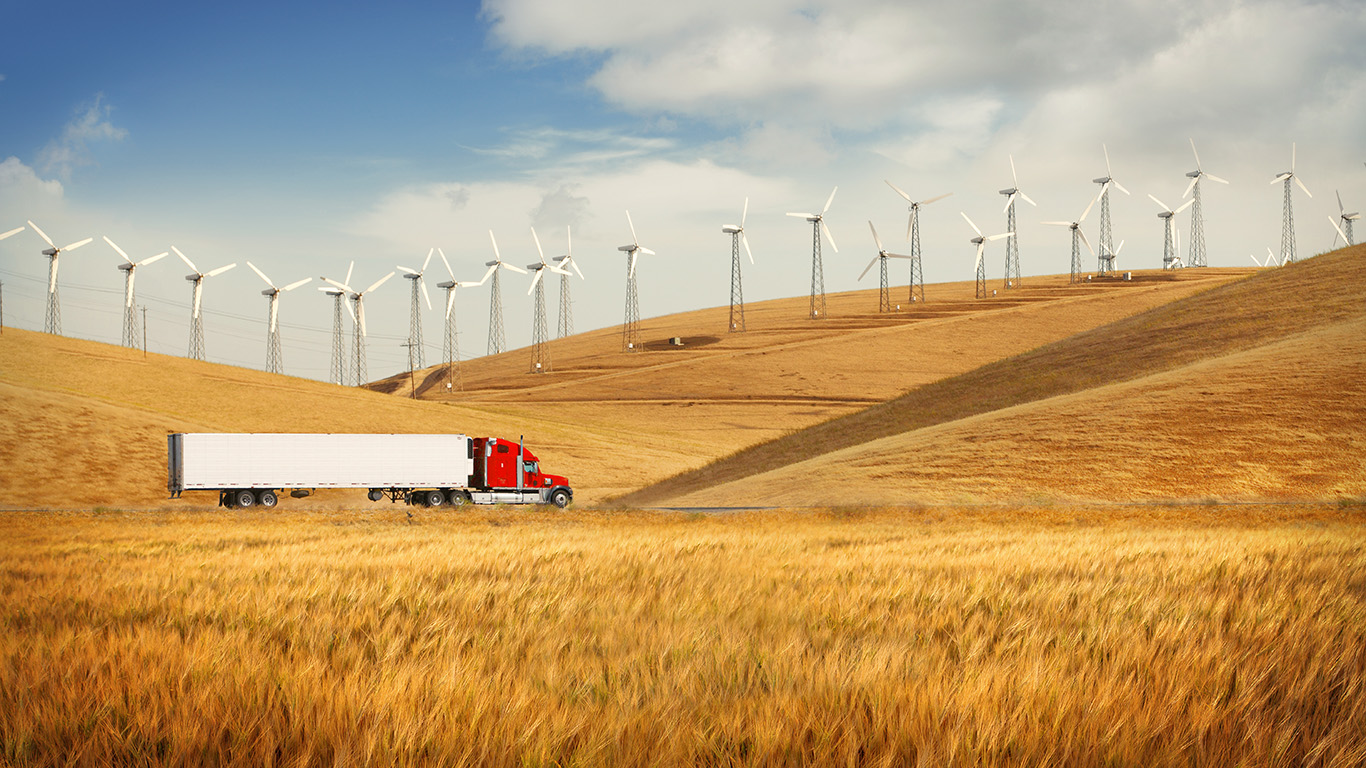 24/7 Wall St.
24/7 Wall St. 24/7 Wall St.
24/7 Wall St. 24/7 Wall St.
24/7 Wall St.


